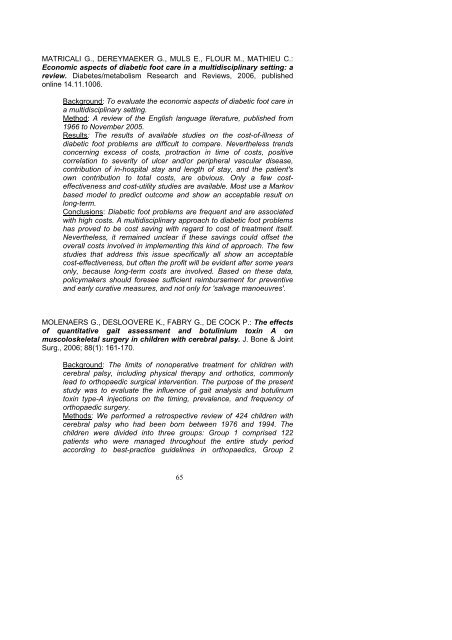2006 - UZ Leuven
2006 - UZ Leuven
2006 - UZ Leuven
Create successful ePaper yourself
Turn your PDF publications into a flip-book with our unique Google optimized e-Paper software.
MATRICALI G., DEREYMAEKER G., MULS E., FLOUR M., MATHIEU C.:Economic aspects of diabetic foot care in a multidisciplinary setting: areview. Diabetes/metabolism Research and Reviews, <strong>2006</strong>, publishedonline 14.11.1006.Background: To evaluate the economic aspects of diabetic foot care ina multidisciplinary setting.Method: A review of the English language literature, published from1966 to November 2005.Results: The results of available studies on the cost-of-illness ofdiabetic foot problems are difficult to compare. Nevertheless trendsconcerning excess of costs, protraction in time of costs, positivecorrelation to severity of ulcer and/or peripheral vascular disease,contribution of in-hospital stay and length of stay, and the patient'sown contribution to total costs, are obvious. Only a few costeffectivenessand cost-utility studies are available. Most use a Markovbased model to predict outcome and show an acceptable result onlong-term.Conclusions: Diabetic foot problems are frequent and are associatedwith high costs. A multidisciplinary approach to diabetic foot problemshas proved to be cost saving with regard to cost of treatment itself.Nevertheless, it remained unclear if these savings could offset theoverall costs involved in implementing this kind of approach. The fewstudies that address this issue specifically all show an acceptablecost-effectiveness, but often the profit will be evident after some yearsonly, because long-term costs are involved. Based on these data,policymakers should foresee sufficient reimbursement for preventiveand early curative measures, and not only for 'salvage manoeuvres'.MOLENAERS G., DESLOOVERE K., FABRY G., DE COCK P.: The effectsof quantitative gait assessment and botulinium toxin A onmuscoloskeletal surgery in children with cerebral palsy. J. Bone & JointSurg., <strong>2006</strong>; 88(1): 161-170.Background: The limits of nonoperative treatment for children withcerebral palsy, including physical therapy and orthotics, commonlylead to orthopaedic surgical intervention. The purpose of the presentstudy was to evaluate the influence of gait analysis and botulinumtoxin type-A injections on the timing, prevalence, and frequency oforthopaedic surgery.Methods: We performed a retrospective review of 424 children withcerebral palsy who had been born between 1976 and 1994. Thechildren were divided into three groups: Group 1 comprised 122patients who were managed throughout the entire study periodaccording to best-practice guidelines in orthopaedics, Group 265

















